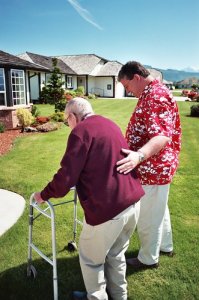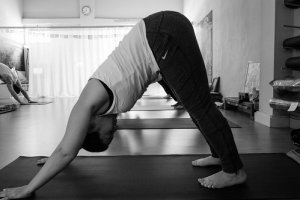Don’t Fall for It
Not all advice is good advice. If you or a loved one are concerned about falling you will want to or likely already have sought out information about fall prevention. As you research you will come across ample information about fall prevention in the media. While it is refreshing that information about fall prevention is available, some but not all the information is beneficial. My my blog will teach you why fall prevention matters and educate you about the information related to fall prevention available in the media.
Why you should you care about fall prevention:
Falls are common:
- 1 in 3 people age 65 and older fall every year
Falls can lead to injury/disability:
- 20-30% of seniors will sustain moderate to severe injuries from falls
- 81% of traumatic brain injuries result from falls
Falls can impact daily life:
- Injures from falls can cause seniors to lose their mobility and/or ability to live on their own
Are there ways to prevent falls?
The information above is disheartening , but yes, there are proven strategies that can help. I have included youTube clips from TV broadcasts that discuss and make recommendations about fall prevention. But wait didn’t you say misinformation also exists? Don’t worry, I have located research that supports or contradicts claims made in the videos.
Home Modifications
Here is a recap of the video:
In the TMJ4 video, the in-home specialist describes options for remodeling a bathroom to reduce falls in the bathroom. One of the options recommended is a tub cut out which involves removing a portion of the tub wall to allow a bathtub to be able to be converted into a walk-in tub. Another option presented is a walk-in bathtub that contains a door for entering the bathtub, a seat to allow someone to sit while bathing and grab bar for someone to hold onto. The third option presented is an access shower which contains a low threshold for someone to step over and grab bars to hold. Lastly, grab bars are mentioned. Thankfully, we learn that grab bars no longer have “a stainless-steel look” and instead come in a variety of different shapes and colors (TMJ4, 2014).
What does the research say about the recommendations?
Unfortunately, no research studies about the effectiveness of walk-in showers and bathtubs Although research studies about the effectiveness of walk-in showers could located occupational and physical therapy providers may recommend a walk-in shower as adaptive equipment (Duke University, n.d). However, research regarding the use of grab grab bars actually exists!
Research by King & Novak (2017) aimed to determine the efficiency of bathroom aids in supporting balance during transfers into and out of a bathtub. Participants were asked to step into and out of a bathtub with wet floors under each of the following conditions: use of a vertical grab bar placed on a side wall, horizontal grab bar placed on a back wall (the long side of a bathtub wall), use of a bath mat as well, only while touching a wall and with no assistance.
It is important to note that the findings support the use of grab bars. While using a vertical grab bar to enter a bathtub, participants had improved balance compared to entering the bathtub with no assistance. When stepping out of a bath tub the older adults in the study had decreased balance when using a horizontal grab bar. There was not a significant difference between stepping into/out of a bathtub with/without a bathmat.
The authors also have some useful recommendations. Based on the results of the study, the authors report that a vertical grab bar is beneficial for entering and exiting a bathtub while a horizontal grab bar is beneficial for assisting with activities for someone is already inside of a bathtub. A bathmat should be used to avid slips.
Source: (King & Novak, 2017)
The takeaway:
To prevent a fall, initialing grab bars and/or a walk-in bathtub may well be worth the time and effort especially if they are recommended to you. Research by King & Novak suggest that grab bars can help. Additionally, occupational and physical therapy providers sometimes required walk-in bathtubs or showers. A little bit of construction in your bathroom may prevent a devastating injury.

By: Tom Britt
Exercise
Video Recap:
The KUTV 2 News clip makes several recommendations to reduce the risk of falls. One recommendation is to get up carefully to avoid getting “dizzy” from blood rushing to your feet. Although not described in the video, this is caused by a condition known as orthostatic hypotension which occurs when a person’s blood pressure drops from changing positions. To combat becoming dizzy the doctor featured in the video recommends doing “five straight leg raises on each side before they sit on the edge of the bed” and the narrator recommends that people “sit for 10 seconds before standing up”.
In the video, you, the viewer are told to “keep active” since exercise can help reduce the risk of falls. The narrator states that “It can be as simple as walking”. The doctor then states that people should “walk for chunks of time” instead of a “big chunk of time”.
Source: (KUTV 2, 2017)
Does research support this?
The research is somewhat mixed. Sitting up slowly and excising before sitting up are recommended by the centers of disease control to avoid a decrease in blood pressure that can make an individual feel dizzy (CDC, 2017). However, the information about exercise is only partially supported by research.
A study conducted by Sherrington et al. (2017) examined past research on the effect of exercise on fall prevention. After analyzing studies, the authors found that the most effective exercise programs incorporated balance training and over 3 hours a week of exercise. When a program included balance training and over 3 hours a week of exercise it lowered the number of falls per senior by 39%. The authors report that the most effective balance programs “aimed to provide a high challenge to balance” (Sherrington et al., 2017, p. 6).
The authors also are made so helpful recommendations. The authors suggested that group exercise, home exercise and Tai Chi as safe ways to improve balance. It is important to note that the authors report that walking on its own is not sufficient to reduce the risk of falls, but that walking can be combed with an exercise program that incorporates a “challenge to balance” (Sherrington et al., 2017, p. 6).
Source: (Sherrington et al., 2017)
The takeaway:
Be careful if you notice that you become dizzy while standing or sitting up! As both the video and CDC suggests, you want to get up slowly and may want to move around before you sit or stand up. The CDC also recommends taking to your doctor about becoming dizzy while standing or sitting up (CDC, 2017). Additionally, walking alone may not help you improve your balance! Remember, the results of the Sherrington et al. (2017) study found that the most beneficial exercise programs incorporated balance training. Therefore, my recommendation is to find an exercise program that incorporates balance training.
Here is a link to some resources about exercise programs that are based on research:
Evidence-Based Falls Prevention Programs
Drinking water?
Video Recap:
In the WBAL-TV video, the guest on the show also makes several recommendations to reduce the likelihood of falls. She makes several recommendations such as installing grab bars, using a nonslip bathmat and strength training that were also recommended in the other media clips. However, she makes a new recommendation for “hydrating before you are going out” and to “drink a couple of bottles so it is already in your system”. The statement “drink a couple of bottles so it is already in your system” implies that people should drink water before becoming thirsty (WBAL-TV, 2017).
What does the Research say?
Drinking water before becoming thirsty is not supported by research! A study by Saker et al. (2014) examined the relation between thirst, drinking fluids and activity in the brain. In the study, water consumption was reported as “pleasant” after exercise but was “unpleasant” as the participants continued to drink water and were no longer thirsty. MRIs (a type of brain scan) were performed while participants were and weren’t thirsty. The MRIs reveled that the activity in the participates brains were different when they were drinking and weren’t drinking water. The authors state that “This inhibitory process could be an important mechanism to protect against the adverse consequences of excessive water intake” (Saker et al., 2014, p. 5380). In other words, the location of activity in a person’s brain may exist to prevent over drinking dangerous amounts of water.
The authors stated that over consumption of water can occur when there is a brain disorder such as schizophrenia (a serious psychiatric condition) or due to false assumptions about hydration. The author provides a scary example of Boston Marathon runners developing hyponatremia (a condition caused by low sodium levels) as a result of false assumptions about over hydrating. The results of the study suggest that people’s brains alert them when they are and are not in need of fluids. Avoiding listening to these signals may be unsafe!
Takeaway:
Over hydrating is potentially dangerous! The results of the study by Saker et al. (2014) suggest that people’s brains alert them when they are and are not in need of fluids. The authors report that people may falsely over drink based on false ideas about how to properly hydrate or if they have a medical condition. The authors implications suggest that unless a person has an impairment in their brain’s ability to determine the amount of water they need they will know when they are and are not thirsty. There is no need to over drink water to prevent dehydration. I would recommend bringing water along while exercising instead over consuming water.

By: Dave Haygarth
Last takeaway:
Remember the main argument: not all information that is available on fall prevention is accurate or appropriate for you! From the compare and contrast from the research to it the videos it is clean that some information is more accurate than others. If you are concerned about falling it is important to talk to your doctor who may refer you to physical or occupational therapy.
Additional Resources:
https://www.cdc.gov/falls/index.html
https://www.ncoa.org/healthy-aging/falls-prevention/
References:
Centers for Disease Control. (2017). Postural Hypotension: What it is & How to Manage it. Retrieved from https://www.cdc.gov/steadi/pdf/STEADI-Brochure-Postural-Hypotension-508.pdf
Duke University: Department of Occupational and Physical Therapy. (n.d). Bathing. Retrieved November 22, 2020, from https://sites.duke.edu/ptot/outpatient-services/patient-resources/bathing/
King, E. C., & Novak, A. C. (2017). Effect of Bathroom Aids and Age on Balance Control During Bathing Transfers. American Journal of Occupational Therapy, 71(6), 1–9. https://doi.org/10.5014/ajot.2017.027136
KUTV 2 News Salt Lake City. (2017, February 20) Check Your Health Fall Prevention for Seniors [Video file]. Retrieved November 9, 2020, from https://www.youtube.com/watch?v=jkeLch47cA0
Saker, P., Farrell, M. J., Adib, F. R. M., Egan, G. F., McKinley, M. J., & Denton, D. A. (2014). Regional brain responses associated with drinking water during thirst and after its satiation. Proceedings of the National Academy of Sciences of the United States of America, 111(14), 5379–5384. https://doi.org/10.1073/pnas.1403382111
Sherrington, C., Michaleff, Z.A., Fairhall, N., Paul, S. S., Tiedemann, A., Whitney, J., Cumming, R., Herbert, R., Close, J. C. T., Lord, S. R. (2017). Exercise to prevent falls in older adults: an updated systematic review and meta-analysis. British Journal of Sports Medicine, 51(24), 1750-1758. https://bjsm.bmj.com/content/bjsports/51/24/1750.full.pdf
TMJ4 News. (2014, September 10) Fall Prevention Awareness Month. [Video file]. Retrieved November 9, 2020, from https://www.youtube.com/watch?v=QPZ7tadsucU
WBAL-TV 11 Baltimore. (2017, July 10) Video: Senior fall prevention [Video file]. Retrieved November 9, 2020, from https://www.youtube.com/watch?v=ZIVnMmsAdfY



Hi- This post had some great information!
I work with the elderly and have some elderly family members that have struggled with falls. Mentioning grab bars for the shower-tub is a great option! Also the note about drinking water and the possibilities of over-hydrating. A lot of people just drink, drink, drink, but listening to your brain is important! Overall so much good information that I can take away, and also supported by references so I know I can trust it. Great work! 🙂
– Lyric C